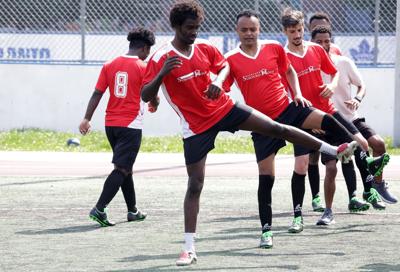When Adam Assadick Khatir first came to Canada for asylum in 2023, he started looking for a place to play soccer before he thought of school.
That speaks to how big soccerÃ˝is for the young African man.
“Everyone plays soccer in Sudan,” said Assadick Khatir, who came as an unaccompanied minor and has since been granted protection in Canada from the war-torn country.Ã˝
In peacetime, said the 18-year-old, “whenever there’s a big game on TV like between Barcelona and Real Madrid, people there would pay and go to the cinemas to watch it on the big screen. Soccer is in our blood.”
The global sport has become a community unifier. In Greater …´…´¿≤, refugee houses under the auspices of the OntarioÃ˝Coalition of Service Providers for Refugee ClaimantsÃ˝have organized the for the clients they serve from around the world, as well as their staff and supporters.
This year’s games will be held July 19Ã˝at the North York Civic Soccer Fields near Bathurst Street and Finch Avenue West, with teams representing eight participating refugee shelters:Ã˝Sojourn House, Adam House, Matthew House, FCJ Refugee Centre, Christie Refugee Welcome Centre, Centre for Refugee Children, Romero House and Peoples House. They’re free for the public to attend.
“The point is not really to win, but to have a day for our clients, the special people that we value,” said Francisco Vidal, executive director of Sojourn House, the host and sponsor of this year’s version of the annual event.
“The tournament offers them an opportunity for something to look forward to and to build community, and maintain healthy lifestyles that mitigate a lot of the issues that are happening in their lives in a new country.”
Although refugee shelters are supposed to offer short-term stays, Vidal said asylum seekers are staying longer in recent years due to the lack of affordable housing. It prompted the refugee houses in part to expand their limited programming to start the first soccer tournament in 2019 as a summer activity, though the games were suspended during COVID.
He said many of the recent arrivals are from Africa or Latin America, and soccer is a great mixer even among people whose homelands are at war with each other.
“We have kids from Congo who are probably not getting along with Rwandans,” said Vidal, who himself came to Canada in 1991 as a refugee youth from El Salvador via Honduras.
“You know how soccer goes. It’s all along national lines and you can get very nationalistic in your mind. We try to provide more like you’re playing for Sojourn House, for example. This is our team and there’s diversity within our players, to try to build bridges.”
Last year, eight teams ‚Äî some made up of a couple of dozen players ‚Äî were cheered on by more than 300 people in the audience; a medical tent was set up, and a trophy was bought, and claimed.Ã˝This year, organizers are introducing third-party referees; the games have become increasingly competitive and serious.
Assadick Khatir started playing street soccer ‚Äî kurat al-qadam in Arabic ‚ÄîÃ˝in grade school because the sport does not require costly equipment and is easily accessible.
“You just need a ball and a field,” saidÃ˝Assadick Khatir, who plays for a …´…´¿≤ soccer academy (scoring with three bicycle kicks to date) and had six goals in last year’s Refugee Club for Adam House. He has switched his allegiance to Sojourn in 2025 since moving into its transitional housing. His team practises three times a week for the event.
“When I play soccer, I forget about everything back home, the family that I left behind, work and all other issues in life.”
Assadick Khatir, who works part-time in restaurants, said soccer in Africa is more for fun and entertainment, and less commercialized,Ã˝but sees the possibility of building a career in North America. He has been admitted to …´…´¿≤ Metropolitan University, York and University of Ottawa for engineering, and would like to go for the tryouts to make their soccer teams and hopefully get a scholarship.
Ruth Granado, who grew up playing street soccer three times a week with boys, gets animated whenever she starts talking about ¥⁄√∫≥Ÿ≤˙¥«±Ù,Ã˝which she said is in Colombians’ DNA. But here in Canada, she doesn’t play much due to other priorities since coming in 2022 to seek asylum from violence among armed groups.
“When babies were born in Colombia, the first thing they look for is a soccer ball,” the 31-year-old early childhood educator said with a chuckle, adding that she used to outrun the guys. “But I’m in a new country and there are other issues to think about than football.”
Granado played defender last year on a coed team for FCJ Refugee Centre and found the tournament a great mixer for people in the community. But she said her team lost at the semifinals because some of the other teams were all-male; she would like to see more girls competing this year.
“It’s just super, super fun, an experience that you can share with others,” said Granado, a fan of the club FC Barcelona, who has been granted protection status in 2023.
Born and raised in India, Tibetan Tenzin Khentse said playing or just watching soccer is a great “escape” from the stress of daily life, and a kind of equalizer. After coming to Canada for asylum in 2021, he has continued to play on pickup teams he finds on apps.
The Refugee Cup is a unique community builder, said the 28-year-old, who is also playing for the FCJ team at the tournament. KhentseÃ˝is a protected person now and works as an anti-human trafficking community co-ordinator.
“This kind of community events makes you connect with other people, so you know that you’re not alone.”Ã˝
































To join the conversation set a first and last name in your user profile.
Sign in or register for free to join the Conversation